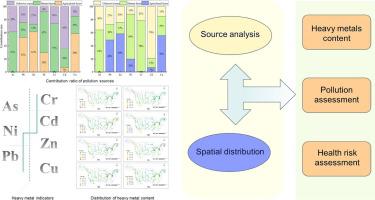当前位置:
X-MOL 学术
›
Sci. Total Environ.
›
论文详情
Our official English website, www.x-mol.net, welcomes your feedback! (Note: you will need to create a separate account there.)
Source-specific probabilistic health risk assessment of heavy metals in surface water of the Yangtze River Basin
Science of the Total Environment ( IF 9.8 ) Pub Date : 2024-03-24 , DOI: 10.1016/j.scitotenv.2024.171923 Xing Chen , Xinyi Fu , Guolian Li , Jiamei Zhang , Haibin Li , Fazhi Xie
Science of the Total Environment ( IF 9.8 ) Pub Date : 2024-03-24 , DOI: 10.1016/j.scitotenv.2024.171923 Xing Chen , Xinyi Fu , Guolian Li , Jiamei Zhang , Haibin Li , Fazhi Xie

|
The detrimental effects of heavy metal accumulation on both ecosystems and public health have raised widespread concern. Source-specific risk assessment is crucial for developing effective strategies to prevent and control heavy metal contamination in surface water. This study aims to investigate the contamination characteristics of heavy metals in the Yangtze River Basin, identifying the pollution sources, assessing the risk levels, and further evaluating the health risks to humans. The results indicated that the average concentrations of heavy metals were ranked as follows: zinc (Zn) > arsenic (As) > copper (Cu) > chromium (Cr) > cadmium (Cd) > nickel (Ni) > lead (Pb), with average concentrations of 38.02 μg/L, 4.34 μg/L, 2.53 μg/L, 2.10 μg/L, 1.17 μg/L, 0.84 μg/L, and 0.32 μg/L, respectively, all below the WHO 2017 standards for safe drinking water. The distribution trend indicates higher concentrations in the upper and lower reaches and lower concentrations in the mid-reaches of the river. By integrating the Absolute Principal Component Scores-Multiple Linear Regression (APCS-MLR) receptor model and Positive Matrix Factorization (PMF) model, the main sources of heavy metals were identified as industrial activities (APCS-MLR: 41.3 %; PMF: 42.1 %), agricultural activities (APCS-MLR: 30.1 %; PMF: 27.4 %), and unknown mix sources (APCS-MLR: 29.1 %; PMF: 30.4 %). The calculation of the hazard index (HI) for both children and adults was <1, indicating no non-carcinogenic or carcinogenic risks. Based on the source-specific risk assessment, agricultural activities contribute the most to non-carcinogenic risks, while industrial activities pose the greatest contribution to carcinogenic risks. This study offers a reference for monitoring heavy metals and controlling health risks to residents, and provides crucial evidence for the utilization and protection of surface water in the Yangtze River Basin.
中文翻译:

长江流域地表水重金属源特定概率健康风险评估
重金属积累对生态系统和公众健康的不利影响引起了广泛关注。针对特定来源的风险评估对于制定预防和控制地表水重金属污染的有效策略至关重要。本研究旨在调查长江流域重金属污染特征,识别污染源,评估风险水平,进一步评估对人类的健康风险。结果表明,重金属平均浓度依次为:锌(Zn)>砷(As)>铜(Cu)>铬(Cr)>镉(Cd)>镍(Ni)>铅(Pb)。平均浓度分别为38.02μg/L、4.34μg/L、2.53μg/L、2.10μg/L、1.17μg/L、0.84μg/L和0.32μg/L,均低于世界卫生组织2017年安全标准饮用水。从分布趋势来看,河流上下游浓度较高,中游浓度较低。通过整合绝对主成分得分-多元线性回归(APCS-MLR)受体模型和正矩阵分解(PMF)模型,确定重金属的主要来源为工业活动(APCS-MLR:41.3%;PMF:42.1%) )、农业活动(APCS-MLR:30.1 %;PMF:27.4 %)和未知混合源(APCS-MLR:29.1 %;PMF:30.4 %)。计算得出的儿童和成人的危险指数(HI)均<1,表明不存在非致癌或致癌风险。根据特定来源的风险评估,农业活动对非致癌风险的贡献最大,而工业活动对致癌风险的贡献最大。该研究为重金属监测、控制居民健康风险提供参考,为长江流域地表水的利用和保护提供重要依据。
更新日期:2024-03-24
中文翻译:

长江流域地表水重金属源特定概率健康风险评估
重金属积累对生态系统和公众健康的不利影响引起了广泛关注。针对特定来源的风险评估对于制定预防和控制地表水重金属污染的有效策略至关重要。本研究旨在调查长江流域重金属污染特征,识别污染源,评估风险水平,进一步评估对人类的健康风险。结果表明,重金属平均浓度依次为:锌(Zn)>砷(As)>铜(Cu)>铬(Cr)>镉(Cd)>镍(Ni)>铅(Pb)。平均浓度分别为38.02μg/L、4.34μg/L、2.53μg/L、2.10μg/L、1.17μg/L、0.84μg/L和0.32μg/L,均低于世界卫生组织2017年安全标准饮用水。从分布趋势来看,河流上下游浓度较高,中游浓度较低。通过整合绝对主成分得分-多元线性回归(APCS-MLR)受体模型和正矩阵分解(PMF)模型,确定重金属的主要来源为工业活动(APCS-MLR:41.3%;PMF:42.1%) )、农业活动(APCS-MLR:30.1 %;PMF:27.4 %)和未知混合源(APCS-MLR:29.1 %;PMF:30.4 %)。计算得出的儿童和成人的危险指数(HI)均<1,表明不存在非致癌或致癌风险。根据特定来源的风险评估,农业活动对非致癌风险的贡献最大,而工业活动对致癌风险的贡献最大。该研究为重金属监测、控制居民健康风险提供参考,为长江流域地表水的利用和保护提供重要依据。



























 京公网安备 11010802027423号
京公网安备 11010802027423号